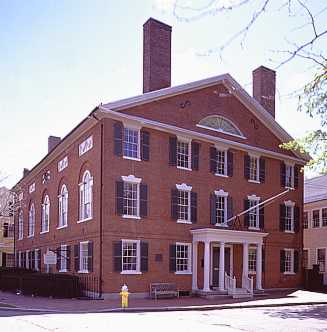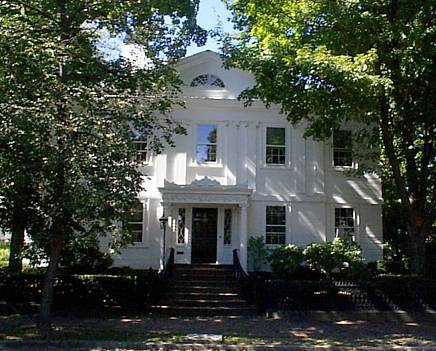The first half of the nineteenth century saw the rise of Salem’s “codfish aristocrats.” These men had acquired substantial fortunes selling salted cod in the West Indies and Europe, and subsequently developed a lively cultural and social life befitting their new found status as the community’s upper crust.
The new hall was the scene of many a fashionable ball attended by the town’s elite. Two of the most exciting functions held there took place in the spring of 1774. On April 28 Salem Tories. including,probably the Willam and Benjamin Pickmans. the Dr. Edward Holyokes, and the Col. William Brownes, gathered at the Assembly Hall to bid farewell to Governor Thomas Hutchinson who was leaving for England. Five weeks later many of the same citizens were in attendance at an Assembly Hall gala to welcome Hutchinson’s replacement, Thomas Gage.
In the fall of 1774 the hall was sold to a group of citizens who had left the Tabernacle Church to form a new religious society. The building was used for worship until 1804-5 when the Proprietors of the South Church hired Samuel McIntire to design their new home on the assembly hall site.
The Assembly Court facility would be replaced as the gathering spot for the town’s wealthier citizens by a new Assembly House which opened on New, now Federal, Street in 1782. The hall was built with funds raised through the sale of stock to Elias Hasket Derby, William Gray, Jr, and others. Approximately 20 men bought a total of about 60 shares.
The new hall was used for a variety of entertainments and functions. Regular assemblies or dances were held in a ballroom which probably ran the length of the back half of the building’s first floor and which could accommodate crowds in excess of 200 people. The dances were augumented by music concerts, theatrical productions, and gambling. In 1791 a Mr. Bowne exhibited his collection of wax figures of famous Americans, including George and Martha Washington and Ben Franklin, at the Assembly House.
The real George Washington was honored with a ball at the Federal Street hall during his visit to Salem on October 29, 1789. Exactly five years earlier the Assembly House had been the scene of a similar party for the Marquis de Lafayette.
In the mid-1790’s William Stearns and Jonathan Waldo acquired almost all of the shares of Assembly House stock from their fellow proprietors. The hall was then sold to a local judge, Samuel Putnam. The noted Salem architect Samuel McIntire redesigned the building as a residence for the judge and his family.
Waldo and Stearns, in conjunction with a third partner, then built the Stearns Block on Washington Street. The building included an elegant second floor function hall named for the nation’s first president.
Washington Hall’s reputation as the place to gather would soon be eclipsed by the appearance of a newer, more elegant facility on Chestnut Street. The building was erected on land acquired by Stephen Phillips from John Neal and was designed by Samuel McIntire. The hall, named for America’s first Secretary of the Treasury, Alexander Hamilton, cost $22,000 and was owned by a group of stockholders led by Phillips, Williard Peele, Pickering Dodge, and Joseph Hodges. In 1820 the owners incorporated as the Proprietors of the South Buildings.

Hamilton Hall
Hamilton Hall served as the gathering place for local Federalists, the political party of wealthy ship owners. The proprietors and their invited guests attended regularly scheduled assemblies where they danced the cotillion, the minuet, and the rigadoon. At ten o’clock the attendees trooped upstairs for a brief repast prepared by the hall’s legendary caterer, John Remond. The evening ended at exactly the stroke of midnight, often in the middle of a dance.
In its early decades Hamilton Hall was also the setting for auctions, plays, concerts, and charity fairs. Special events included a Charles Dickens Tea Party and a Leap Year Party. The latter was a nineteenth century version of the Sadie Hawkins dances of recent decades. .Men were invited to attend by a woman, and once the dancing began the women took the lead in choosing partners.
The hall’s second floor ballroom hosted a number of galas honoring important early nineteenth century political and military leaders. Among them were Salem resident and statesman Timothy Pickering, Massachusetts Governor Christopher Gore, and William Bainbridge, Commodore of the frigate Constitution.
One of Hamilton Hall’s most exciting moments was a party honoring the Marquis de Lafayette during his second visit to Salem in 1824. Approximately 300 gentlemen of the town joined in toasting the beloved Frenchmen in the hall which had been decorated for the occasion by their wives and other local women.
Today, a plaque commemorating the event can be seen at the western entrance to the building. The marker was a gift to Hamilton Hall from the American Friends of Lafayette in 1965.
Jim McAllister
All rights reserved



